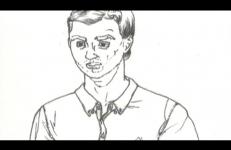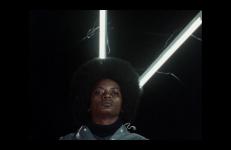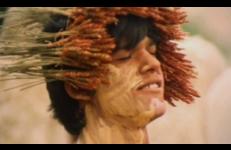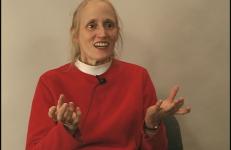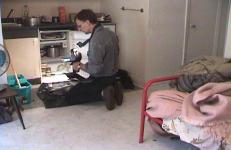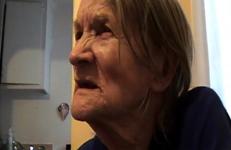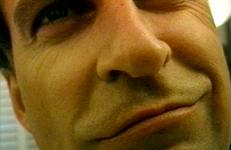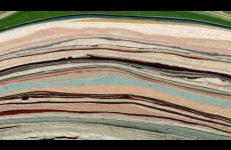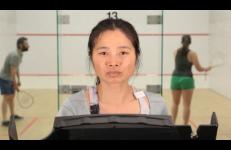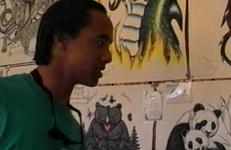This is the burial hymn for thousands of souls in the anthropocentric times. The ghosts of the American way of life. Part of the Hauntology series.
Death and Dying
A Body in a Cemetery is a 15-min short film that documents a place-inspired solo performance by dancer/choreographer Eiko Otake in Green-Wood Cemetery, the U.S.’s second oldest cemetery in Brooklyn that holds 570,000 "permanent residents." Presented in September 2020 by Pioneer Works and Green-Wood Cemetery, this event was for many the first time attending a live performance since the pandemic shutdown.
A Body in Fukushima is a film created by dance artist Eiko Otake consisting of still photographs, inter-titles, and an original score. Photographs are selected from tens of thousands taken by historian/photographer William Johnston of Otake alone in the surreal landscapes of post-nuclear meltdown Fukushima, Japan. Otake edited the film and sound, which includes original music by Kronos Quartet’s David Harrington.
M+ Museum presented A Body in Hong Kong in two locations as part of Mobile M+: Live Art, 2015. The second site she chose and performed at on December 11 and 12, 2015 was the West Kowloon Cultural District, the site where the M+ Museum would be built. Eiko perhaps covered a longer distance in this performance than any other in the past. This raw landscape, rather unusual in Hong Kong, and its political tenderness play as a background of her performance. A Body in Hong Kong is part of Otake’s ongoing project, A Body in Places.
During February and March of 2016, Danspace Project presented Platform, a month long curated program for which Eiko's solo project, A Body in Places, was the focus. At the center of the Platform's dense programs were Eiko's daily solos. Eiko presented 21 performances of A Body in Places in different locations at different times of day and night. In A Body in the East Village, both the camera and the gaze of the audience members closely follow three of these intimate and spontaneous performances.
Eiko Otake, based in the United States since 1976, is a highly regarded artist who has performed in many countries as part of the performance duo Eiko & Koma. Her solo project A Body in Places has attracted much attention since it began in 2014, and she performs it for the first time in Japan.
Eiko Otake performed a version of her solo project, A Body in Places, as a part of River To River Festival on Wall Street. A Body on Wall Street won “Best Use of Location” for Round 3 of Dare to Dance in Public (D2D) Film Festival in 2020.
Camera by Alexis Moh.
Conceived, performed, and edited by Eiko Otake.
For the November 13, 2015 opening of the Hiroshima Panels by Iri and Toshi Maruki at Pioneer Works, Eiko performed her solo in honor of the Hiroshima Panels and their creators. Japanese-style painter Iri Maruki, born in Hiroshima, and Western-style painter Toshi Maruki, who went into Hiroshima city just three days after the bombing. The artists decided to paint the panels together, which illuminate the human experiences of the Atomic Bomb. They spent 30 years painting the fifteen Hiroshima Panels, six of which were on display at Pioneer Works in Red Hook, Brooklyn.
Take a peek at scenes extracted from a videomaker's life. See him amid the glittering domain of glamour being given an award for his work visual work. Meet some of his family, including the "furry ones" – (his cats and rainbow coated dog), and stroll along with him into the deep woods at twilight.
Commissioned by Boston Dance Umbrella, this work was created during a month-long residency in Boston. Clayton Campbell painted a mythological scene of the river that a dying person crosses to reach the world of the dead. The piece was first titled as Eye Below but later changed to By The River.
CB is an experimental bio-pic: its heroine, Charlotte Brontë. A collaboration between Doug Ischar and Tom Daws, CB was commissioned by the Laumeier Museum, St. Louis, for their inaugural Nightlight series.
CB is an experimental bio-pic: its heroine, Charlotte Brontë. A collaboration between Doug Ischar and Tom Daws, CB was commissioned by the Laumeier Museum, St. Louis, for their inaugural Nightlight series.
The Chocolate Factory is a suite of monologues in the voice of a fictionalized serial killer, one monologue for each victim. The camera, with an almost structuralist rigor, pans up and down simple line drawings of each of the seventeen victims. A Black Sabbath song, picked apart and extended, serves as punctuation and soundtrack. Reinke has described the video as, "My autobiography as Jeffrey Dahmer." But really, as the narrator says, "It's all about the victims."
To keep a promise made to her dying mother, a young woman goes off in search of her father, a womanizer she has never met. Along the way, she soon learns that he is dead. But that doesn’t change her plans, she still intends to find him. Carried by the spell-binding rhythm of the Maloya, a ritual chant from Réunion Island, Cilaos explores the deep and murky ties that bind the dead and the living.
come lontano is a perverse historical romance in which two lives are exposed, inter-mixed, doused with sentiment, and — hopefully — redeemed. The work revolves around a central ‘couple’ — Pier Paolo Pasolini and Maria Callas. There is a third main character, an ambiguous villain made of steel, glass and rubber. Each member of our central couple has her/his own external distractions which impinge — to varying degrees — on their brief, ecstatic encounter. This encounter was in fact a cinematic collaboration; it’s product the film Medea (1969).
In this interview American filmmaker, poet, and lyricist, Cecelia Condit gives shape to the contours of her work process. The artist describes the influence of her relationship with her mother, her long-term investment in the macabre, and her ongoing desire to confront death through art. While covering a broad range of topics, Condit’s discussion of her work and interests returns to several defining themes: aging, grotesqueness, and the notion of movement, both in terms of her own past as a dancer and the notion of the body in decay. With a particular emphasis on the production and context of her videos, Annie Lloyd (2008), and All About a Girl (2004), this interview offers insight into the artist’s fascination with aging, sweetness, and storytelling, while also articulating her joyful sense of discovery within the art-making process. No longer working with scripts, Condit presents herself in the interview as a scavenger–much like the crows she incorporates into her work–assembling videos which straddle the line between strange and silly. – Faye Gleisser
Coyolxauhqui recasts the mythical dismemberment of the Aztec Moon goddess Coyolxauhqui by her brother Huitzilopochtli, the deity of war, the Sun and human sacrifice. The film is a poem of perception, one that unveils how contemporary Mexican femicide is linked to a patriarchal history with roots in deeper cultural constructs.
In his signature photographic style, Donigan Cumming eulogizes a dying friend through his exploration of “culture” in all its manifestations: 1. culture: a particular civilization at a particular stage 2. culture: the tastes in art and manners that are favored by a social group 3. culture: all the knowledge and values shared by a society 4. culture: the growing of micro-organisms in a nutrient medium 5. culture: the raising of plants or animals.
In this video, made soon after the death of his mother Stella, we accompany George to the wake, and on to a trip to Albert Maysles holiday home on Fisher's Island.
"Deep waters flow around the living, dead and inanimate objects that bring this picture to life on the wide screen tapestry of electronic reality. Come and join the young and old of eastern energies as they bask in the sun and shadows of past sins and future fortunes. See how the other side lives and devours the fruits and nuts that pepper this great nation with neon nutrients worthy of Broadway and beyond!"
The police phoned. They left a message on the machine. They said he was dead. The video unwinds through stories of sex for rent, unclaimed bodies, cigarette burns, and other monuments of life’s long run from wall to wall. Cut the Parrot is three grotesque comedies in one: the stories of Gerry, Susan, and Albert. Songs of hope and heartbreak spill from the mouths of the performers. The order of impersonation rules.
Dad’s Stick features three objects that my father showed me shortly before he died. Two of these were so well-used that their original forms and functions were almost completely obscured. The third object seemed to be instantly recognizable, but it turned out to be something else entirely.
Eiko & Koma created Dancing in Water: the Making of River as the first video work for the Retrospective Project. Often produced in collaboration with environmental groups and park officials, River is an outdoor work Eiko & Koma performed in nine different sites. River usually takes place in a body of moving water, and the journey downstream suggests the passage of life and time. This video follows Eiko & Koma from rehearsals in the Catskills to performances in the Delaware River and the American Dance Festival.
This video is a moving personal documentary about Danny, a friend of Kybartas who died of an AIDS-related illness in 1986. This powerful work explores the reason for Danny’s return home and his attempts to reconcile his relationship with his family members who had difficulty facing his homosexuality and his imminent death. Retracing Danny’s memory of his once-high lifestyle in the clubs and gyms of Miami, Danny avoids sentimentalizing its subject as it juxtaposes images, text, and voice-over to build a sense of the psychological struggle brought on by Danny’s impending, premature death.
A portrait of risk and language, DAREDEVILS, presents the experimental narrative of a writer as she interviews a well-known artist and feels the reverberations of their discussion throughout her day. Visually spare, still and verbose, the video considers three formal handlings of language—a dialog, two monologues and a song.
Starring KimSu Theiler, Flora Coker and Adam Robinson, shot by Matthew Thompson, and featuring the voices of Susan Howe and Jenny Graf, DAREDEVILS constructs a metaphor of an artist’s life and work as daredevilry.
This title is only available on Kip Fulbeck Selected Videos: Volume One.















